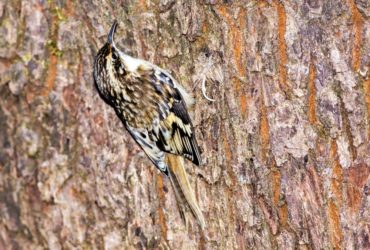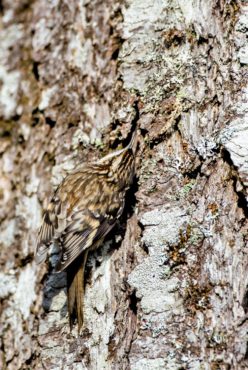
If a hiker in a Kitsap forest were to come upon someone looking through a pair of binoculars, it is only natural to ask what he or she is seeing. If the response is “brown creeper,” some people may think the individual is watching an insect. Actually, the brown creeper is a small songbird that is fairly common in Kitsap forests, despite being seldom seen.
In 1948, naturalist W.M. Tyler wrote: “The brown creeper, as he hitches along the bole of a tree, looks like a fragment of detached bark that is defying the law of gravitation by moving upward over the trunk, and as he flies off to another tree, he resembles a little dry leaf blown about by the wind.” Seventy years later, there is still no better way to describe this stealthy little songbird’s daily activities.
The brown creeper is cryptically colored in brown and tan tones that provide effective camouflage against tree bark. When threatened, it relies on its ability to blend in by flattening itself against the tree and remaining still until the danger has passed.
The brown creeper forages by creeping upward, often spiraling around a tree trunk, finding insects and spiders among the crevices in the bark. It then uses its long, decurved (downward curved) bill to snatch up the hapless arthropods for a tasty meal.
Like a woodpecker, it has a long, stiff tail and large claws that provide stability and grip, allowing it to hitch its way up a tree. It also uses these built-in tools to creep upside-down along large tree limbs in search of additional prey. Since it is only designed to climb upward, when it reaches the higher branches, the brown creeper flies to the base of another tree to begin a new ascent.
The brown creeper is North America’s only member of the treecreeper family. In Washington, it is a year-round resident of coniferous, deciduous and mixed forests, particularly those with mature tracts of Douglas fir.

This species also resides in western and northeastern forests of the United States throughout the year. In winter, Midwestern and Southern states host migrants that breed in Canada.
A summer stroll through a mature Kitsap forest yields a good chance of finding this secretive songbird. Although the brown creeper may be hard to see, it is not impossible to find. It can be difficult to detect from behind, as its camouflage allows it to almost disappear into the pattern of the bark. This is especially true when a brown creeper is foraging on preferred Douglas fir.
The trick to finding one is to look for moving tree bark. A side view resembles a knot climbing the tree. Another feature to seek out is its white underparts, the bird’s only feathers that contrast with brown bark.
The male’s territorial song does not match its diminutive size but resounds through the woods. The series of tweets seems to exclaim: “I’m a brown creeper!” Contact calls are made using a variety of high-pitched chirps. Breeding season is from April to July.
Although they favor live trees for foraging, dead trees, called snags, are typically used for nesting. But unlike such species as chickadee and nuthatch, the brown creeper rarely nests in an old woodpecker hole. Instead, it prefers to build a nest cup of wood chips, moss, leaves, lichen and feathers behind a piece of peeling tree bark.
This may sound precarious, but the brown creeper is an innovative thinker. It secures the nest to the loose bark by attaching it with sticky spider silk and cocoons. The female is primarily responsible for building the nest, but the male assists by bringing her construction materials.
The female typically lays five or six eggs and incubates them for 14-17 days. During this time, the male brings her food. Both parents are exceptionally vigilant around their nest, approaching it clandestinely from the lower portions of the tree.
The nestlings leave the nest about two weeks after hatching. Upon fledging, the brood splits in two, with each group following a parent for two or more weeks until they are ready to face the world on their own.
In Washington, brown creeper populations are stable, but in some states, it is a species in decline. Its biggest threat is habitat loss. Since it depends on mature forests and snags, survival of the brown creeper is imperiled when such habitat is diminished, fragmented or destroyed.
The brown creeper is an indicator species of forest health. Its presence is a sign of a vigorous forest, while its absence may indicate problems within the ecosystem.
Kitsap’s forests are full of hidden treasures waiting to be found. The furtive brown creeper is one of them and it is no ordinary bird. Even the most experienced birders appreciate an encounter with one.























Comments